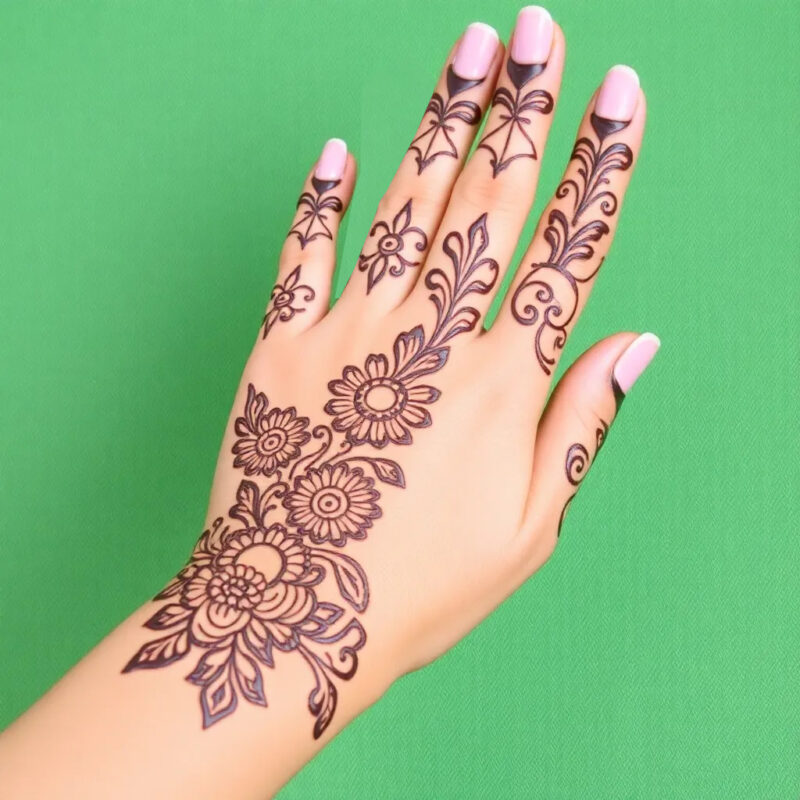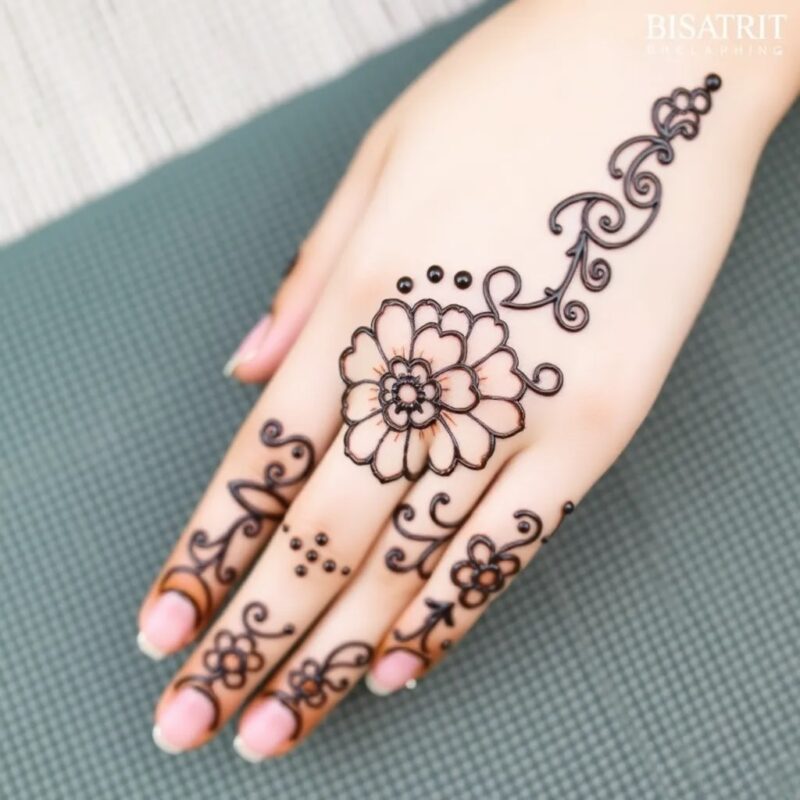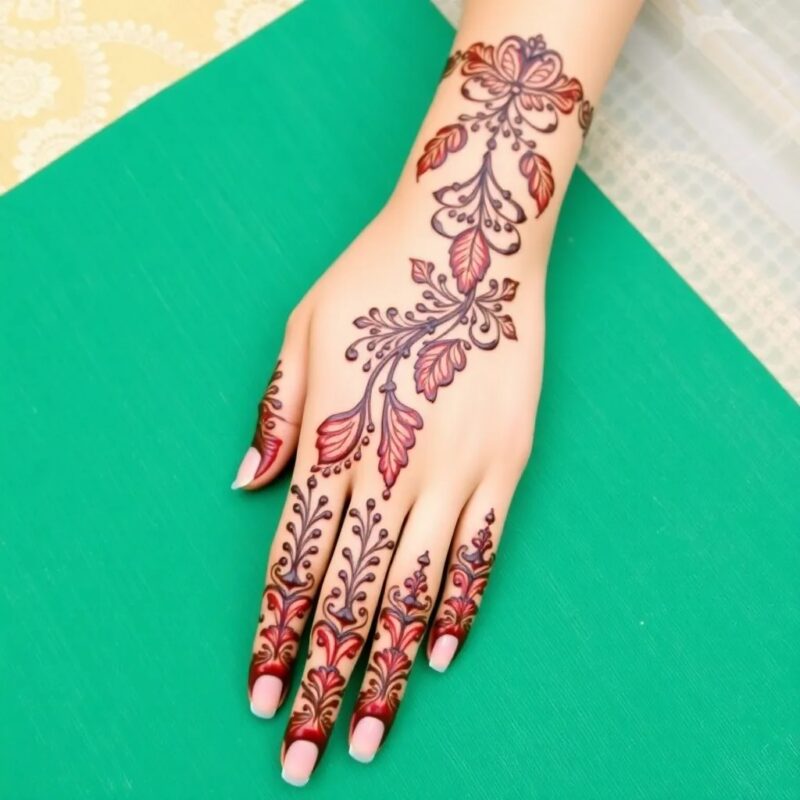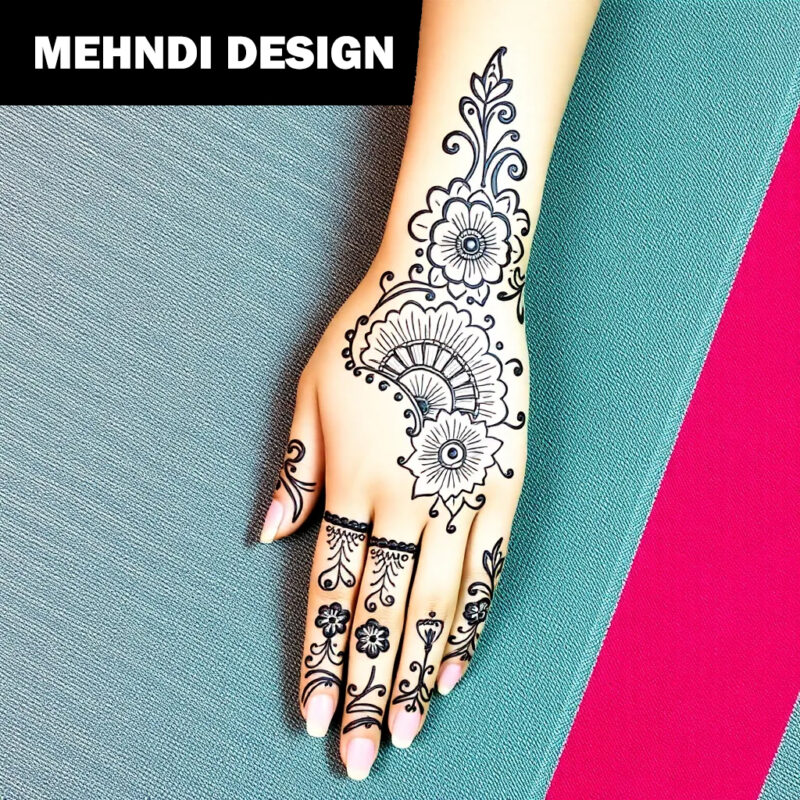Introduction to Mehndi Design
Mehndi Design, also known as henna, is more than just an art form—it’s a cultural expression with roots that span across the Middle East, Africa, and South Asia. Mehndi Design detailed body art reflects the deep connection between beauty, tradition, and identity.
Historical Significance of Mehndi

Tracing back thousands of years, mehndi was initially used for cooling the body. With time, it evolved into an artistic tradition, representing celebration, protection, and a touch of mystery.
Modern-Day Appeal of Mehndi

Today, mehndi has crossed cultural borders. It’s embraced worldwide, especially in fashion and festivals, where people celebrate this art’s beauty and versatility.
Types of Mehndi Designs
Indian Mehndi

Known for its complex and detailed patterns, Indian mehndi often includes peacocks, flowers, and other intricate motifs.
Arabic Mehndi

With bold, less intricate designs, Arabic mehndi focuses on floral patterns that are spaced out elegantly.
Moroccan Mehndi

Characterized by its geometric shapes and symmetry, Moroccan mehndi has a unique appeal.
Popular Mehndi Styles for Every Occasion
From weddings to festivals, mehndi designs vary widely, with specific styles for each occasion, lending a personalized touch to every celebration.
Bridal Mehndi: Tradition and Trends

Bridal mehndi is one of the most cherished traditions in many cultures. Brides spend hours adorning their hands, arms, and feet with intricate patterns symbolizing joy, luck, and prosperity. Traditional bridal mehndi is highly detailed and covers large areas, often including the groom’s name or initials hidden within the design—a playful tradition that adds to the excitement of wedding celebrations.
Modern trends have introduced a fusion of styles, where brides blend traditional Indian designs with Arabic or Moroccan patterns. Some brides even add personalized elements like meaningful symbols or motifs that represent their story. Whether it’s an elaborate full-hand design or a minimal, elegant pattern, bridal mehndi continues to be a cherished symbol of new beginnings.
Mehndi Design for Festivals and Celebrations
Beyond weddings, mehndi holds a special place in festivals like Diwali, Eid, Karva Chauth, and Teej. The patterns for these events are generally simpler and quicker to apply but still carry the festive spirit. For Eid, intricate florals are popular, while Diwali designs often include symbols of lights and diyas, aligning with the festival’s themes.
Mehndi application has also become popular at informal gatherings like baby showers and birthday parties, where guests can enjoy unique designs as part of the celebration. This versatility makes mehndi an art form that is relevant across various events, blending tradition with contemporary celebration.
Symbolism in Mehndi Patterns
Every line and motif in mehndi has a story. Here’s a look at some common symbols:
- Peacock: Represents beauty and elegance.
- Flowers: Symbolize joy and happiness.
- Paisley: Often a symbol of fertility and growth.
- Vines and Leaves: Reflect longevity and devotion.
Each symbol holds deep meaning, making every design unique and personal. Brides often choose patterns that reflect their wishes, beliefs, and traditions, turning their mehndi into a tapestry of their journey.
Materials Used in Mehndi Application
Traditionally, mehndi is made from the dried leaves of the henna plant, ground into a fine powder. This powder is mixed with water, lemon juice, or essential oils to create a paste. Today, many mehndi artists use pre-made cones, which make it easier to apply intricate designs.
Organic and chemical-free henna is preferred for a rich, dark stain and to avoid skin irritation. Some artists also add natural ingredients like coffee or tea to darken the color, creating a richer effect on the skin.
How to Choose the Perfect Mehndi Design
Choosing the right mehndi design depends on personal style, the occasion, and even the outfit. Here’s a quick guide:
- Traditional Events: Go for detailed patterns with classic symbols like peacocks, paisleys, and florals.
- Festivals: Simpler designs work well for quick application and a festive look.
- Weddings: Consider full-hand designs that extend up to the elbows and include personalized elements.
With endless styles and combinations, you can work with your artist to create a unique design that speaks to you.
Applying Mehndi: Tips for Beginners
If you’re new to mehndi, start with simpler designs. Here are a few tips:
- Practice the Basics: Try drawing straight lines, dots, and circles before moving on to complex designs.
- Work with a Cone: The cone is an essential tool for precision; practice controlling the flow for consistent thickness.
- Start Small: Apply a small design on your hand or wrist, gradually moving to larger areas as you gain confidence.
Common Mistakes to Avoid in Mehndi Application
Learning mehndi requires patience. Here are a few pitfalls to watch out for:
- Applying Too Thick a Layer: This can cause the paste to smudge and affect the design.
- Not Waiting Long Enough: For a darker stain, it’s essential to leave the paste on until it dries fully.
- Using Water Too Soon: After removing the paste, avoid water contact for a few hours to deepen the color.
Caring for Your Mehndi Design
To help your mehndi stain last longer and appear darker, follow these steps:
- Avoid Water for the first 24 hours.
- Apply Lemon and Sugar: A mixture of lemon juice and sugar can help seal the design and improve stain quality.
- Keep Warm: Body warmth intensifies the color, so keeping your hands warm can help develop a deeper stain.
Removing Mehndi: Tips and Tricks
If you need to lighten or remove your mehndi, here are some options:
- Exfoliate: Use a scrub to gradually lighten the design.
- Soak in Warm Water: A saltwater soak can help fade the color.
- Lemon and Baking Soda: This mixture can also aid in lightening the stain, but avoid overuse to prevent skin irritation.
Pros of Mehndi
| Pros of Mehndi | Details |
|---|---|
| Natural and Safe | Mehndi is made from the henna plant, making it a natural and generally safe option for most skin types compared to chemical-based body art. |
| Temporary Body Art | Mehndi fades naturally over time, allowing individuals to enjoy temporary body art without long-term commitment, making it easy to experiment with different designs. |
| Cultural and Traditional Significance | Deeply rooted in cultural and religious practices, mehndi is used to celebrate special occasions like weddings and festivals, adding a sense of tradition and meaning. |
| Customizable Designs | Mehndi offers a variety of design styles (Indian, Arabic, Moroccan), allowing for personalization based on individual taste and occasion. |
| Non-Permanent and Painless | Unlike tattoos, mehndi is painless and non-permanent, making it an ideal choice for those who prefer body art without discomfort or long-lasting effects. |
| Cooling Properties | Mehndi is believed to have cooling properties that can help soothe the skin, especially in hot climates, adding a functional benefit to its aesthetic appeal. |
Cons of Mehndi
| Cons of Mehndi | Details |
|---|---|
| Temporary and Short-Lasting | While temporary nature is a benefit, it can also be a drawback for those wanting longer-lasting designs, as mehndi typically fades within one to three weeks. |
| Risk of Allergies | Some people may experience allergic reactions, especially to synthetic or black henna, which can contain harmful chemicals. |
| Time-Consuming Application | Intricate mehndi designs require time and patience to apply, often taking hours for detailed bridal or full-hand designs. |
| Limited Color Options | Mehndi generally stains in shades of brown to red-orange; those looking for different colors may not find mehndi suitable. |
| Fading and Maintenance | Mehndi requires care to maintain its color, as frequent exposure to water and detergents can speed up fading, impacting the quality and longevity of the design. |
| Potential Staining | Mehndi paste can stain clothes and other surfaces if not handled carefully, leading to possible stains that are hard to remove. |
Conclusion: Embracing Mehndi in Everyday Life
Mehndi has grown far beyond its traditional roots, embraced globally as a form of self-expression and artistry. Whether it’s a wedding, a festival, or simply a personal choice, mehndi adds beauty and significance to life’s celebrations. With designs that span cultural and personal styles, mehndi connects us to our roots while allowing a creative twist that fits any occasion.
Frequently Asked Questions (FAQs)
What is the difference between henna and mehndi?
Both terms often refer to the same practice, but “henna” is the plant used, while “mehndi” refers to the art of applying henna designs.
How long does mehndi last on the skin?
Typically, mehndi can last between one to three weeks, depending on the skin type and care.
Can I remove mehndi if I’m not happy with the design?
While it won’t disappear instantly, gentle exfoliation and natural methods can help fade it faster.
Is it safe to use colored mehndi cones?
It’s best to use natural, organic henna to avoid irritation. Colored cones often contain dyes and chemicals that may not be safe.
How do I ensure my mehndi turns out dark?
Letting it dry fully, avoiding water, and applying lemon-sugar can help deepen the color.
How long does it take for mehndi to dry?
Mehndi typically takes 30 minutes to an hour to dry, but it’s best to leave it on for several hours to get a darker stain.
Why is lemon and sugar applied to mehndi?
A lemon-sugar mixture is often applied to mehndi to keep it moist, allowing the dye to release more effectively, resulting in a darker stain.
Can children apply mehndi?
Yes, children can apply natural mehndi, but it’s best to avoid synthetic or black henna, which can contain harmful chemicals.
Does mehndi work on all skin tones?
Mehndi shows up well on most skin tones, though the shade of the stain may vary slightly depending on skin type and care.
How can I make my mehndi last longer?
Avoid water for the first 24 hours, keep your skin warm, and avoid using lotions or oils on the area to help the mehndi last longer.




